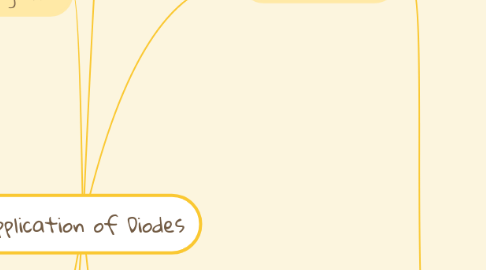
1. Voltage Regulator
1.1. Voltage Regulator IC
1.1.1. look like transistor
1.1.2. Have 3 legs
1.2. Zener Diode Regulator
1.2.1. Operating Range
1.2.2. Breakdown Characteristics
1.2.3. Voltage Regulation
1.2.4. Equivalent Circuit
1.2.5. Characteristic Curve
1.2.6. Aplications
1.2.6.1. Regulation with varying input voltage
1.2.6.2. Regulation with varying load
1.3. System designed to maintain a constant voltage level
1.4. A voltage regulator may use a simple feed-forward design or may include negative feedback
2. Clamper
2.1. Types of Clamper
2.1.1. Simple Clamper
2.1.1.1. Negative
2.1.1.1.1. Shift the input waveform so that the signal is pushed downward by the circuit
2.1.1.1.2. the positive peak of the input signal coincides with the zero level
2.1.1.2. Positive
2.1.1.2.1. shift the input waveform so that the signal is pushed upward by the circuit
2.1.1.2.2. negative peak of the signal coincides with the zero level
2.1.2. Biased Clamper
2.1.2.1. Positive
2.1.2.2. Negative
2.1.2.3. enable to shift a waveform so that it occurs above or below a DC reference voltage other than 0V
3. Switch
3.1. Forward Biased Diode
3.1.1. acts like a ON switch
3.1.1.1. Vsource has to overcome Vb to let diode to conduct
3.1.1.2. R and diode's body resistance limits amount of current that going through the diode
3.1.1.3. provide a conduction diode that has a constant voltage drop across it (also known as turn on voltage)
3.1.1.3.1. Silicon : VD(on) = 0.7V Germanium : 0.25V
3.1.1.3.2. Current is permitted
3.2. Reverse Biased Diode
3.2.1. acts like a OFF switch
3.2.1.1. if the reverse voltage source is increased, the diode will reach a point that called Breakdown Voltage
3.2.1.2. after the Breakdown voltage is reached, diode will conduct current heavily causing of its destruction
4. Rectifier Circuits
4.1. Power Supply
4.1.1. Linear Power Supply
4.1.1.1. Def :Constant current path between its input and its load
4.1.1.2. Basic Components
4.1.1.2.1. Rectifier
4.1.1.2.2. Filter
4.1.1.2.3. Voltage Regulator
4.1.2. Switching Power Supply
4.1.2.1. Def : intermittent current path between its input and its output
4.2. Convert ac energy to dc energy
5. Clippers
5.1. Types of Clippers
5.1.1. Series clippers
5.1.1.1. Positive
5.1.1.2. Negative
5.1.1.3. the diode in series with load
5.1.1.4. diode in series clipper 'clips' any voltage that does not forward biased
5.1.2. Parallel Clippers
5.1.2.1. Positive
5.1.2.2. Negative
5.1.2.3. Diode parallel with load
5.1.2.4. Series resistor Rc acts as limiter to avoid any damage to the diode or other component
5.1.3. Biased Clippers
5.1.3.1. Series
5.1.3.1.1. adding of DC source in series with the clipping diode changes the effective forward bias of the diode
5.1.3.2. Parallel
5.1.3.2.1. Positive
5.1.3.2.2. Negative
5.1.3.2.3. Positive and Negative (2 batteries)
5.1.4. Zener clippers
5.1.4.1. Batteries are replaced by zener diodes
5.1.5. Two Stages clippers
5.1.6. Clipper circuits have the ability to 'clip' off a portion of the input signal without distorting the remaining part of the alternating waveform
6. Voltage Multiplier
6.1. A special type of diode rectifier circuit which can potentially produce an output voltage many times greater than of the applied input voltage
6.2. commonly use in transformer
6.3. use a combination of diodes and capacitors to step up the output voltage of rectifier circuits
6.4. Types
6.4.1. Voltage Doubler
6.4.1.1. an electronic circuit that charges the capacitor from the input voltage and switches these charges - voltage is twice at the output for the ideal case
6.4.1.2. switching elements are diodes
6.4.1.3. the output is taken across the second capacitor
6.4.1.4. Types
6.4.1.4.1. Half wave voltage doubler
6.4.1.4.2. Full wave voltage divider
6.4.2. Voltage Tripler
6.4.2.1. first positive half cycle a)D1 conducts b) charging the C1 to Vm
6.4.2.2. first negative half-cycle a)D2 conducts b)charging the C2 to 2Vm
6.4.2.3. Second positive half cycle a)D3 and D1 will conduct b)charging C1 and the voltage across C2 charges C3 to the same value 2Vm
6.4.2.4. Thus, the voltage across C1 and C3 is 3Vm
6.4.3. Voltage Quadrupler
6.4.3.1. first positive half cycle a)D1 conducts b)charging the C1 to Vm
6.4.3.2. first negative half cycle a)D2 conducts b) charging the C2 to 2Vm
6.4.3.3. Second positive half cycle a)D3 and D1 will conduct b) charging C1 and the voltage across C2 charges C3 to the same value 2Vm
6.4.3.4. Second negative half cycle D2 and D4 conducts, leading to charging C3 charging C4 to the same peak value 2Vm
6.4.3.5. Thus the voltage across C2 and C4 is 4Vm
